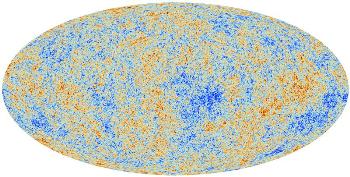Mar 22 2013
The Planck satellite, launched in 2009 by ESA (the European Space Agency) examines the origin of the Universe: after almost three years the data regarding the first fifteen months of observations have finally been published, describing a Universe that is still in its 'child' phase.
 Cosmic microwave radiation background anisotropies observed by Planck (Credits: ESA/Planck Collaboration)
Cosmic microwave radiation background anisotropies observed by Planck (Credits: ESA/Planck Collaboration)
Besides numerous international agencies, also three Trieste institutes take part in the initiative: the International School of Advanced Studies, Osservatorio Astronomico of Trieste (INAF) and Università di Trieste.
"We are very excited, we are finally seeing the concrete results of so many years of hard work". This is how the scientists of the Planck project have commented the first data resulting from the observations carried out by Planck. The mission of the ESA satellite is to observe the past of our Universe, going back in time and reaching the very first instant right after the Big Bang. The image that the Planck scientists convey today is that of a 'child' Universe, dating back to about 380,000 years after the Big Bang, when its temperature was similar to that of the most external layer of a star today.
The Planck satellite, the result of the collaboration of several European aerospace agencies including the Italian one (ASI), was launched in May 2009. From that moment onwards it has been endlessly observing the Universe’s fossil radiation. In Trieste scientists have analyzed data delivered by the LFI (Low Frequency Instrument), the instrument that detects the radiation within the 30 to 70 GHz interval. The Trieste team, which comprises SISSA and INAF-Osservatorio Astronomico, with the collaboration of Università di Trieste, has contributed to the drafting of about thirty papers that were published today, 21 march 2013, in the journal Astronomy & Astrophysics.
"The maps we have obtained feature levels of resolution and sensitivity never achieved before, a milestone in modern cosmology", explains Andrea Zacchei, a researcher at the Osservatorio Astronomico of Trieste who, following Fabio Pasian, is now in charge of the entire data analysis of the LFI. "In a year’s time the challenge will be even greater, as we will try to conclude the analysis of polarization data which may give us a few surprises regarding our comprehension of the Universe". The polarization is in fact the "direction" taken by the light, perpendicular to that in which it travels, that "remembers" very well the one that had been impressed on the Big Bang and it may therefore convey very important information.
"The observations carried out by Planck reveal with unprecedented exactness the imprint of the Big Bang on the fossil radiation. This the first time that man can look with such clearness at the origin of our Universe, in which we see the impact of forms of matter and energy still unknown today", adds Carlo Baccigalupi, a cosmologist at SISSA. "In order to comprehend Planck’s data we still have to focus on the most mysterious part of the signal, in which we may look for space-time oscillations of cosmological dimension, and such information that may help identify the physical processes that occurred at the time of the Big Bang. A lot of work for scientists for many years to come". The task of Baccigalupi, alongside Luigi Danese, Francesca Perrotta and the SISSA group, is to extract the signal of the Big Bang and the main astrophysical emissions.
More in detail...
Planck is a satellite of the European Space Agency, designed to observe the Big Bang through the cosmic background radiation with unprecedented results.
Planned in the mid-90s, the satellite and the instruments it carries on board have been realized thanks to the huge effort of various European space agencies, while NASA created the cooling system.
Planck carries on board two instruments to observe the sky at several frequencies: the LFI (Low Frequency Instrument), under Italy’s responsibility, which detects the radiation in the 30 to 70 GHz interval and the HFI (High Frequency Instrument), under France’s responsibility, that observes it in the 100 to 857 GHz interval.
The analysis of the satellite-to-ground data has been carried out at two centers only in the world, Paris and Trieste. Trieste in particular, with SISSA, INAF-Osservatorio Astronomico and Università di Trieste, acts as the Data Processing Centre for the low-frequency instrument. In recent years about fifteen scientists from the three institutes have been collaborating zealously with continuous exchanges with the other Planck collaborators, that include the world’s greatest experts in data analysis, computer science, cosmology and astrophysics, amounting to over 200 scientists and technicians.